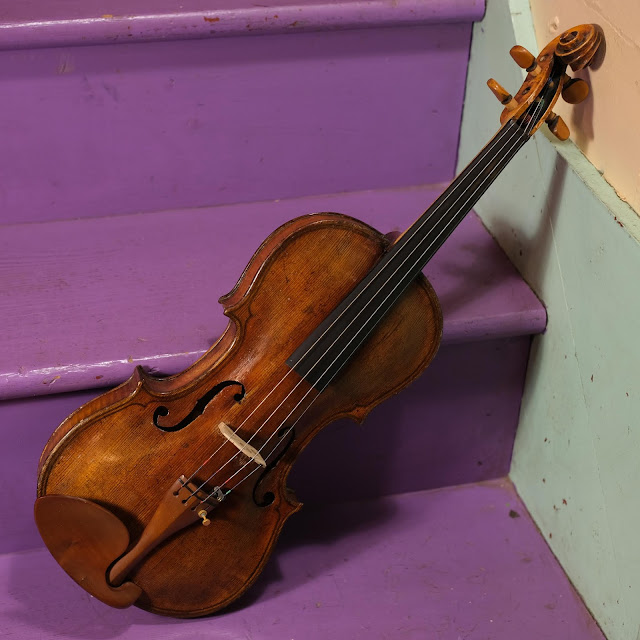1880s Unmarked Amati-Style 4/4 Violin
Update 2020: Some old seam repairs had let loose and so I backburnered this violin until I could get a chance to fix them. I've done that, fit a new bridge, and now it's good to go again! I've updated the photos and made a new video clip. Back to the original post info...
This sweet-voiced fiddle is curious and was used for decades as the main instrument of a New England "country dance" fiddler/banjo player. It bears a Jerry Wee(ne, de?), Boston repair inscription inside from 1995 and that must've been the last time this instrument had much work done on it.
This sweet-voiced fiddle is curious and was used for decades as the main instrument of a New England "country dance" fiddler/banjo player. It bears a Jerry Wee(ne, de?), Boston repair inscription inside from 1995 and that must've been the last time this instrument had much work done on it.
It looks like an 1870s/1880s fiddle but it's possible it was made earlier. It's probably German-import considering the ebonized-maple fingerboard and overall build, but it's quirky and offbeat in its looks (check out the cool purfling at the points) and has a high arch to the top that make it a lot more interesting than the usual fare.
While the boxwood pegs, tailpiece, and chinrest are clearly not original, everything else save the bridge is at least outwardly "period." Inside the instrument, however, one can tell that work has been done. It has a couple of cracks glued-up on the top (I cleated and filled one of them) and I'll bet it was the 1995 repair job that involved installing a new bass bar. The finish looks like it's original but has been given a topcoat at some point.
Work included: regluing some old seam repairs that'd sprung, fitting a new bridge, adusting the soundpost, and setting it up. It came with good-quality strings but I'm assuming synthetic-core strings like Dominants would give this instrument even more of a sweet/sultry voice.
Setup notes: it plays well and is quick on the left hand which would suit a fiddler. The neck has a hair of relief overall but it is not significant. The strings seem to be some sort of rope-core set of good quality.
Condition notes: there's lots of wear and tear throughout but it's all elegant. It looks like it had some "pre-aging" (as in -- relic-style work) done when it was made (which was common at the time) but it's also gained "actual" wear and tear including a couple of tight, repaired top cracks. Its fittings aside from the fingerboard are all replacements and the bass bar has been replaced within the last 20+ years. The tailpiece almost touches the top but doesn't under tension. A taller saddle for the tailgut may be required at some point.
Setup notes: it plays well and is quick on the left hand which would suit a fiddler. The neck has a hair of relief overall but it is not significant. The strings seem to be some sort of rope-core set of good quality.
Scale length: 12 7/8"
Nut width: 7/8"
String spacing at nut: 1 11/16"
String spacing at bridge: 1 1/2"
Body length: 14"
Lower bout width: 8"
Waist width: 4 1/8"
Upper bout width: 6 1/2"
Side depth at endpin: 1 1/2" with +5/8" top/back arch -- quite high
Top wood: solid spruce
Back/sides wood: solid figured maple, one-piece back
Neck wood: maple
Bracing type: tonebar
Fretboard: ebonized maple
Bridge: recent maple/ebony-insert replacement
Neck feel: slim C shape
Condition notes: there's lots of wear and tear throughout but it's all elegant. It looks like it had some "pre-aging" (as in -- relic-style work) done when it was made (which was common at the time) but it's also gained "actual" wear and tear including a couple of tight, repaired top cracks. Its fittings aside from the fingerboard are all replacements and the bass bar has been replaced within the last 20+ years. The tailpiece almost touches the top but doesn't under tension. A taller saddle for the tailgut may be required at some point.
It has an excellent, roadworn hard case that seems to date around 1900-1910.























Comments
Thanks for asking!